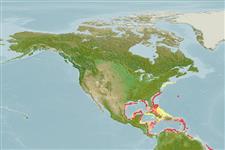>
Ovalentaria/misc (Various families in series Ovalentaria) >
Opistognathidae (Jawfishes)
Etymology: Opistognathus: Greek, opisthe = behind + Greek, gnathos = jaw (Ref. 45335); to the very elongate upper jaw of the type species of the genus, Opistognathus nigromarginatus (Ref. 128653); nothus: From the Latin 'nothus' meaning false or counterfeit, alludes to the erroneous initial belief that the female holotype was the sexually dimorphic counterpart of O. melachasme males; noun in apposition (Ref. 26893).
Environment: milieu / climate zone / depth range / distribution range
Ecologia
marino demersale; distribuzione batimetrica 92 - 100 m (Ref. 26893). Subtropical
Western Central Atlantic: off North Carolina (USA), Gulf of Mexico, and Cuba.
Size / Peso / Age
Maturity: Lm ? range ? - ? cm
Max length : 7.9 cm SL maschio/sesso non determinato; (Ref. 26893)
Short description
Morfologia | Morfometria
Spine dorsali (totale): 10; Raggi dorsali molli (totale): 14; Spine anali 2; Raggi anali molli: 13; Vertebre: 28. Anterior nostril a short tube without cirrus on posterior rim; posterior end of maxilla rigid, not produced as a thin flexible lamina; coronoid process of articular hatchet-shaped with dorsal margin straight; vomer edentate; inner lining of maxilla and adjacent membranes with conspicuous black stripe; spinous dorsal fin without an ocellus; segmented dorsal and anal fin rays 14 and 13 respectively; caudal vertebrae 18 (Ref. 26893).
Life cycle and mating behavior
Maturità | Riproduzione | Deposizione | Uova | Fecundity | Larve
Smith-Vaniz, W.F., 1997. Five new species of jawfishes (Opistognathus: Opistognathidae) from the western Atlantic ocean. Bull. Mar. Sci. 60(3):1074-1128. (Ref. 26893)
IUCN Red List Status (Ref. 130435)
Threat to humans
Harmless
Human uses
Informazioni ulteriori
Nomi ComuniSinonimiMetabolismoPredatoriEcotossicologiaRiproduzioneMaturitàDeposizioneSpawning aggregationFecundityUovaEgg development
Age/SizeAccrescimentoLength-weightLength-lengthLength-frequenciesMorfometriaMorfologiaLarveDinamica popolazioni larvaliReclutamentoAbbondanzaBRUVS
BibliografiaAcquacolturaProfilo di acquacolturaVarietàGeneticaElectrophoresesEreditarietàMalattieElaborazioneNutrientsMass conversion
CollaboratoriImmaginiStamps, Coins Misc.SuoniCiguateraVelocitàModalità di nuotoArea branchialeOtolithsCervelliVista
Strumenti
Special reports
Download XML
Fonti Internet
Estimates based on models
Preferred temperature (Ref.
123201): 21.5 - 25.8, mean 23.2 °C (based on 5 cells).
Phylogenetic diversity index (Ref.
82804): PD
50 = 0.5000 [Uniqueness, from 0.5 = low to 2.0 = high].
Bayesian length-weight: a=0.00389 (0.00180 - 0.00842), b=3.12 (2.94 - 3.30), in cm total length, based on all LWR estimates for this body shape (Ref.
93245).
Trophic level (Ref.
69278): 3.4 ±0.5 se; based on size and trophs of closest relatives
Fishing Vulnerability (Ref.
59153): Low vulnerability (10 of 100).
